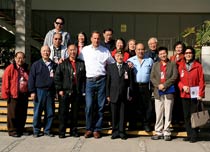Earlier this month, GLAST arrived at the Astrotech payload processing facility near the Kennedy Space Center to begin final preparations for
its May 2008 launch. (Image courtesy of NASA/Kim Shiflett.)
GLAST Has Eyes for Gamma Rays
by Matt Cunningham
Deciphering the genetic code of the universe is no easy task. Yet that's just what the Gamma-ray Large Area Space Telescope's Large Area Telescope (LAT) seeks to accomplish. Integrated at SLAC in 2005 and 2006 from hardware fabricated at laboratories all around the world, the LAT will use its 880,000 silicon strips to detect high-energy gamma rays with unprecedented resolution and sensitivity, filling in gaps in understanding left by previous missions and pushing new boundaries in particle physics and astrophysics.
"The LAT will give us a broad representation of the evolution of objects that are the highest energy accelerators in the universe," said SLAC Professor Elliott Bloom.
As GLAST orbits the earth, gamma rays—emanating from jets of plasma streaming from enormous black holes, pulsars and other astronomical sources—will strike the LAT. By determining the time of each gamma ray's arrival, the direction from
where it came and energy it carries—the fundamental quantities of astronomy—the LAT will yield a wealth of new data that will offer a glimpse into the fundamental nature of
high-energy processes in the universe.
Read more...
|

Paul Golan:
Cycles of Commitment
by Matt Cunningham

Paul Golan For Paul Golan's last job, he flew 75,000 miles a year. When he landed at night, Golan noticed the bright glow of cities; if one out of every four light bulbs were turned off, he thought, everybody would still have enough light but we would be using a lot less energy.
When Golan moved to California to become SLAC's Department of Energy Site Office Manager, he made a commitment to ride his bike to work everyday. And he has—riding 26
miles a day to and from SLAC.
"By focusing on little things everyday, we all can consume less energy and set
a good example for children," he said.
The only time that Golan drives is when it rains or he takes his kids somewhere. Over the six years that he lived in Washington D.C., he relied on public transportation and his bike, so that he only drove his car a handful of times.
The wide swath of bike lanes and trails in the area has allowed Golan to extend his goal to include not only his commute, but a total of 200 miles every week. Riding all those miles alone can be invigorating Golan said, but meeting fellow cyclists is a fun part as well. The other day Golan met someone who
had done his graduate work at SLAC, and they had an eight-mile long conversation.
"The community within bike commuters is very close knit," he said. "When you get a flat tire, you'll have about 10 people offer help."
Golan is no exception. He goes so far as to carry snacks, money and clothes along with tools, spare-tire tubes and a first aid kit for emergencies. About a month ago he stopped to fix another cyclist's tire.
"She wanted to give me money, but of course I refused," Golan said. "It's an unwritten law that you never accept money for giving help."
Golan doesn't ordinarily ride in big events, but he's making an exception for an upcoming ride to raise funds for the American Diabetes Association. Along with his two sons, he will be riding a 50-mile stretch for the
Tour de Cure, which will
take place in Palo Alto on June 8th.
|
WIS Seminar:
What are You Doing for the Rest of Your Life?
by Cherrill Spencer
In this afternoon's Women's Interchange at SLAC (WIS) seminar, Women Rethink Retirement: What are you doing for the rest of your life?, Financial Advisor Rhonda Wentzel will discuss how the face of retirement is changing. She will also offer some innovative ways to look at
our typical questions:
- What will my retirement look like?
- When will it happen?
- How do I get there?
Wentzel observes that women are beginning to look at retirement as a beginning, not an end, and will discuss how
to pursue dreams and goals at the right pace, and on the right terms.
The seminar takes place today, March 26th, at 12:00 p.m. in Panofsky Auditorium. All are invited to attend.
Photo of the Day: American Legion Visit
by Matt Cunningham

Click on image for larger version. Members of the American Legion
and their families met with representatives from the Department of Energy Stanford Site Office for a small taste of SLAC science and history on Monday. The
group stopped at the Klystron Gallery and the visitor's center at the Panofsky Auditorium. Visitors also got the chance to view the
Linac Coherent Light Source construction site and the Research Yard overlook.
Conservation Tip
of the Week
by John Steward

The California Energy Codes will soon be adopted and they are scheduled to be implemented early next year. The changes introduced to the California Energy Code will have some far-reaching affects on residential homes as well as commercial facilities. If you are planning any major remodeling or building a new home, energy regulations will be driving a majority of your design decisions—from windows, to roofs, to space conditioning, ventilation and lighting.
To learn more about the new energy codes you can view Energy Commission Documents at
www.energy.ca.gov. The Residential Compliance Software Manual is available in PDF format and the new changes are highlighted in red.
|

Events
Lab Announcements
Community Bulletin Board
|





 <%
Response.AddHeader "Last-modified", getArticleDate()
'Response.AddHeader "Last-modified","Mon, 01 Sep 1997 01:03:33 GMT"
'Monday, December 06, 2010
%>
<%
Response.AddHeader "Last-modified", getArticleDate()
'Response.AddHeader "Last-modified","Mon, 01 Sep 1997 01:03:33 GMT"
'Monday, December 06, 2010
%>